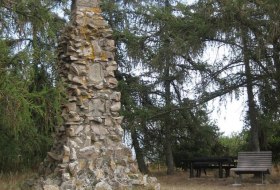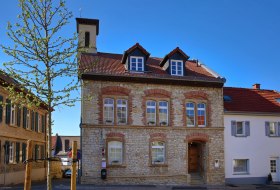
searchMenu


Bad Münster am Stein-Ebernburg
The Rheingrafenstein is a 136 m high porphyry rock formation on the Nahe opposite Bad Münster am Stein-Ebernburg. Geologically, it belongs to the Kreuznach Massif. On its top stands the ruins of Rheingrafenstein Castle, which was built in the 11th century and destroyed during the Palatinate War of Succession in 1688. The Rheingrafenstein is the landmark of the Bad Kreuznach district of Bad Münster am Stein-Ebernburg. Somewhat below it is the ruined outer castle of Affenstein. A 200-hectare area around the rock formation was…

The present property "Alte Schmiede Wettig" was a forge workshop from 1776. The workshop with its equipment and tools is still in its original state of the 1920s. The barn and stables offer space for exhibitions, music, literature and theme evenings.

Anyone who has mastered Sprendlingen's sporting ascent on the high-altitude hiking trail will see an extraordinary tower on the hill between Ober-Hilbersheim and Sprendlingen - the Napoleonsturm. The Napoleon's Tower with its signal arms is modelled on a historical telegraph pole, with which the first short messages were sent over a distance of 12 kilometres in Napoleonic times. So to say the first SMS in history. The signal arms correspond to the "Chappe system", which was developed by the Chappe brothers in France at the time of the French…

The eagle monument is situated on the Mühlberg and is a war memorial from the first world war. Probably it was already inaugurated during the war what was really unusual during this time. The building type, it's created with field stones, also makes it special.

The town hall building was erected in 1851/52. The ridge turret contained the fire bell that warned of fire danger. The ground floor housed the equipment for extinguishing fires. The entrance to the fire engine room was on the west side. In former times, the Schöffenhaus (aldermen's house) stood on the site of the town hall. It is mentioned as early as 1394 as a respectable two-storey building with an attached bakehouse. There is also evidence of a forge leaning against the north in 1508. The community forge with stables was abandoned in…

The Oswaldhöhe is a vantage point from which you can let your gaze wander over the Rhine-Hessian village of Bornheim. There is also a table of wine here.

The cross vault of the former winegrowers' farm is used in the Augenwaide as a sales room for flowers and decorations. The origin of the typical Rhine-Hessian vaults dates back to the early 19th century. In the course of secularisation, during which church properties, among other things, were nationalised, farm animals moved into cross-vaulted cellars for the first time. Lightweight brick was easy to work with and did not rot; it was also fireproof and more hygienic. Another reason for this construction method is the tried-and-tested…

As a supplement to the Hildegard exhibition in the neighboring Museum am Strom, the garden displays numerous plants that Hildegard described in her natural history ("Physica"). In this important collection, the learned Benedictine described almost 300 herbs, shrubs and trees with their (healing) effects on humans. Unfortunately, the work has survived only in late medieval copies, so that today no one knows the "original text" of Hildegard von Bingen. The didactically designed Hilde Garden presents the "Book of Plants" and the "Book of Trees"…